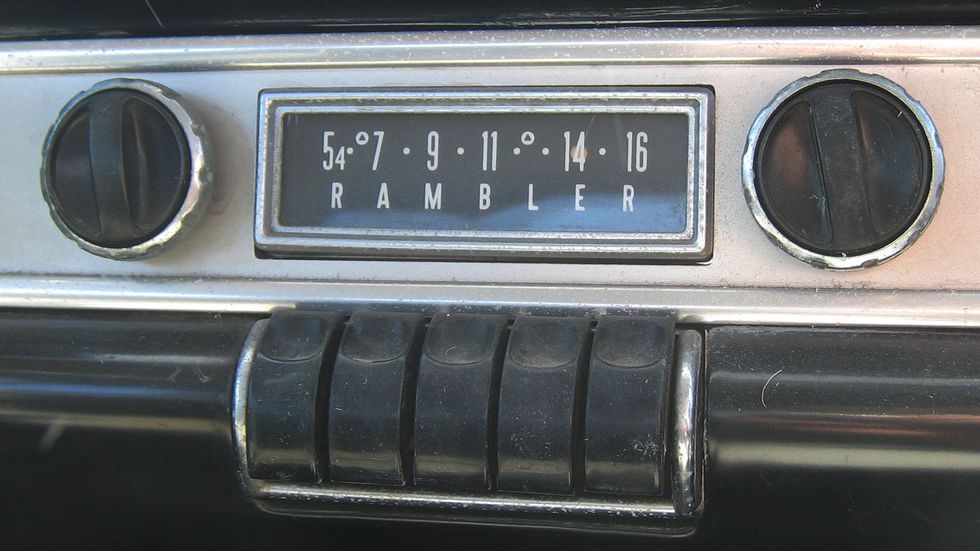Tuning In or Tuning Out?
February 8, 2024
“We can put a man on the moon, but we can’t get a radio to play inside a tunnel,” my father growled when whatever AM station he was listening to on the car radio disintegrated into unintelligible static as we entered an underpass dug through a Western Pennsylvania hillside.
A half-century later, we’re struggling to put a man, a woman, or anything on the moon, and AM radio, once as standard on a new car as tires and a windshield, may go the way of ashtrays and window cranks.

Manufacturers want to move away from AM because of meager listenership and the static interference from EV's electric motors, making the band unlistenable. They say drivers can stream it through listening platforms if they want to listen to AM. Or pay for it. But Congress is trying to force them to continue to provide AM radio as a standard option in new cars. Proponents of the AM Radio for Every Vehicle Act of 2023 say it remains the backbone of the Emergency Alert System and still provides necessary information to communities and individuals.
I haven't given much thought to tunnels or AM radio for years. Hillsides are as rare in the Midwest as a decent slice of pepperoni pizza, let alone one big enough to dig holes and drive through. And the last time I regularly listened to AM broadcasts, Bill Clinton claimed he wasn’t having sex with that woman, and OJ Simpson said he didn’t kill one.
KDKA was my go-to station in the 60s and 70s. Like it was for most Western Pennsylvanians. It's also the historic genesis of broadcast radio. It generated the first commercial radio broadcast on November 2, 1920, announcing the presidential election results between Warren G. Harding and James Cox. Harding won. In August of the following year, they aired the first play-by-play broadcast of a major league baseball game between the Philadelphia Phillies and the hometown team, the Pittsburgh Pirates. The Pirates won. I enjoyed writing that. I don't get the chance very often.
I woke up every morning to the antics of morning drive-time legend Jack Bogut. In the afternoons my pocket transistor radio was tuned to the station’s playlist of pop hits, evenings were for Pirate baseball, and, after heading to bed, I would pop an earphone in to eavesdrop on KDKA’s talk radio hosts. The conversations were less extreme than today’s talk radio, and the conspiratorial tin-hat callers were more entertaining than alarming. AM radio was also a connection to a broader world. Because of something called the ionosphere and a cooling lower atmosphere, we tuned in stations from all over the country at night. AM radio also introduced us to DIY, with many of my friends and I building our own AM radio sets from kits. Today’s youngsters build superfast gaming computers; my generation built a radio that, if you were lucky, received two stations and only gave you minor electrical shocks. Then FM came along and introduced static-free disco and rock and roll, and before long, I was part of the group that helped FM unseat AM as the first choice of radio listeners.
Recently, when I saw the news story about auto manufacturers getting ready to erase AM radio off their window stickers and Congress’s move to stop them, I was surprised AM radio was still a thing. I assumed that with satellite and streaming services, AM and FM radio were slowly going the way of 8 track tape decks. I was wrong. (At this point, my family is copying those words for later use). Ninety percent of adults still listen to the radio, and of those who do, only twenty-nine percent of their listening time is dedicated to streaming. Most of the time, they're tuned into AM or FM and listening in their cars. Only about a third of radio listeners still choose one of the 4500 remaining AM stations nationwide. FM is still the reigning king since it rose to prominence in the late 70's.
Once again, I'm in the minority. I rarely listen to the radio, streaming most of my music and information. And if I do listen to a radio broadcast – yep – it's streamed. In the car and out. Intrigued, I took a return trip down the AM broadcast highway. I was in Montana and parked alongside the Madison River after sundown, enjoying the sight of a star-filled sky absent the intrusion of artificial lights. My rental car still had an AM radio and a good old combustion engine, so there was no pesky EV static. I took a tour up and down the dial and connected with stations in Alberta, Saskatchewan, Los Angeles, and Denver, among others. The accompanying static and fading signals, radio-style news stories, locally produced commercials, and the familiar voice pattern of AM broadcasters (even in French) were nostalgic. I found myself missing the old radio band and considered reconnecting. I remained tuned to one of the stations on my drive back to town.
The following morning, when I got in the car and started it up, I was hit with a blast of static from the still AM-tuned radio. The distant signal was lost to the sun’s interference. I didn't search for a closer and clearer one; my nostalgia was lost to convenience. My phone reconnected via Bluetooth, and I brought up a Spotify playlist.
Although I have a renewed appreciation for radio and its relevance for most of the country, and even if AM radio remains vital to our emergency alert system, requiring manufacturers to keep AM standard in all cars seems like government overreach. If drivers want AM, they can purchase the option or stream it. The government should spend their time on more important things.
Like putting us back on the moon. If we were ever there in the first place. I heard an interesting story on KDKA late one night in the 70’s about NASA staging moon landings…
Like what you read?
Subscribe to my mailing list and get notifications to your inbox when my next blog post goes live.
Contact Us
More By Joe


